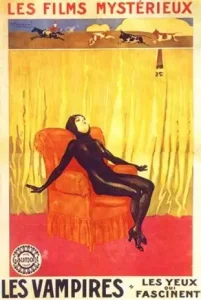Shadows & Silk: How Louis Feuillade's 'Les Vampires' (1915-16) Hypnotized a World and Invented the Modern Thriller!
In the chaotic, formative years of cinema, amidst the global turmoil of World War I, French director Louis Feuillade was quietly (and prolifically) revolutionizing the very concept of serialized storytelling, laying the groundwork for genres from the espionage thriller to the superhero saga. Far from the vaudeville sketches that dominated early film, Feuillade understood the magnetic power of suspense, mystery, and an ongoing narrative that kept audiences returning week after week. His masterful serials, particularly Fantômas and the later Judex, were immensely popular. But it was Les Vampires (1915–16), an audacious, ten-part silent epic, that truly captivated the public imagination and left an indelible mark on cinematic history. This sprawling crime thriller, with its enigmatic villains and chilling atmosphere, didn't just entertain; it established many of the conventions of the modern suspense narrative, proving that film could build complex mythologies and create truly iconic, mysterious anti-heroes, cementing its status as a groundbreaking, essential cult classic.
Les Vampires plunges us into the labyrinthine criminal underworld of Paris, following the relentless pursuit of journalist Philippe Guérande (Édouard Mathé) as he attempts to expose the truth behind "the Vampires"—a ruthless, shadowy secret society of master criminals who commit a series of audacious, almost supernatural, heists and murders across the city. His primary adversary, and the true star of the show, is the utterly captivating, chameleon-like Irma Vep (Musidora), the Vampires' chief operative. Irma Vep, an anagram for "vampire," is a femme fatale unlike any seen before: a stunning, agile, and utterly amoral woman who can disguise herself as a maid, a male dandy, or a society lady, all while performing daring acrobatics, scaling walls, and orchestrating intricate schemes. The serial is a whirlwind of daring escapes, clever traps, and a palpable sense of urban paranoia, as the lines between law and crime, reality and illusion, constantly blur.
Louis Feuillade's direction is a marvel of early cinematic ingenuity, leveraging long takes, minimal cutting, and a keen eye for framing to create a sense of realism within its fantastical narrative. He often shot on actual Parisian streets and rooftops, lending an authentic, almost documentary-like feel to the unfolding criminal escapades, contrasting sharply with the theatricality of many contemporary films. The serial's episodic structure builds tension brilliantly, leaving audiences on cliffhangers week after week, a format that would influence everything from radio serials to modern television. But it's Musidora's iconic portrayal of Irma Vep that truly elevates the serial to legendary status; her mesmerizing gaze, slinky black catsuit, and enigmatic allure made her an instant, rebellious icon, inspiring avant-garde artists (like the Surrealists) and countless cinematic villains to come.
Les Vampires was a massive commercial success upon its release, enthralling French audiences and solidifying Feuillade's reputation as a master of suspense. Despite its popular appeal, it initially faced some criticism for its perceived glorification of crime, yet its artistic and historical significance is undeniable. Louis Feuillade directed all ten episodes. Musidora as Irma Vep became an international sensation, an early example of a cinematic anti-heroine capturing the public imagination. The serial also starred Édouard Mathé as Philippe Guérande and Marcel Lévesque as Mazamette. Its influence can be seen in the works of directors like Fritz Lang, Alfred Hitchcock, and even the French New Wave. Les Vampires remains a captivating cult classic, a sprawling, atmospheric, and utterly addictive journey into the shadowy heart of early cinematic crime.
Director: Louis Feuillade.
Cast: Musidora as Irma Vep, Édouard Mathé as Philippe Guérande, and Marcel Lévesque as Mazamette.
Special Info/Trivia: Les Vampires is a ten-part French silent film serial, released over 1915 and 1916. Musidora's portrayal of Irma Vep (an anagram for "vampire") in a sleek black catsuit became an iconic image and a landmark for the femme fatale archetype. The serial was known for its realistic on-location shooting in Paris, contrasting with its fantastical criminal plot. It was a huge commercial success and influenced many later filmmakers and artists. The film's themes and style have often been embraced by Surrealist artists.

